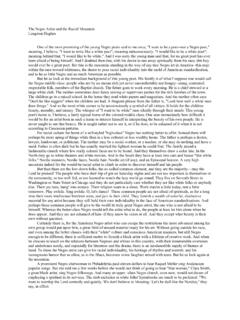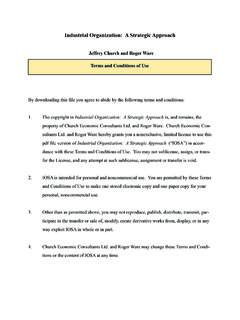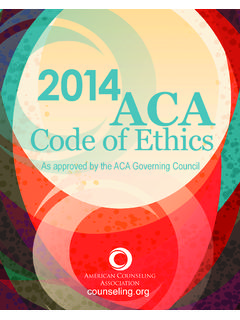Transcription of Stages of Small-Group Development Revisited
1 group & organization Studies, December 1977, 2(4),419-427. Copyright 1977 by International Authors, Stages of Small-Group Development Revisited Bruce W. Tuckman Mary Ann C. Jensen The purpose of this review was to examine published research on Small-Group Development done in the last ten years that would constitute an empirical test of Tuckman's (1965) hypothesis that groups go through these Stages of forming, storming, norming, and performing. Of the twenty-two studies reviewed, only one set out to directly test this hypothesis, although many of the others could be related to it. Following a review of these studies, a fifth stage , adjourning. was added to the hypothesis, and more empirical work was recommended. Tuckman (1965) reviewed fifty-five articles dealing with Stages of Small-Group Development in an attempt to isolate those concepts common to the various studies and produce a generalizable model of changes in group life over time.
2 He examined studies of (1) therapy groups, (2) human relations training or T-groups, and (3) natural and laboratory-task groups in terms of two-realms task and interpersonal. The way members acted and related to one another was considered group structure or the interpersonal realm;. the content of the interactions as related to the task was referred to as the task-activity realm. Both realms represented simultaneous aspects of group functioning because members completed tasks while relating to one another. The Model As a result of the literature reviewed, Tuckman proposed a model of developmental Stages for various group settings over time, labeled (1) testing and dependence, (2) intragroup conflict, (3) Development of group cohesion, and (4) functional role relatedness. The Stages of task activity were labeled (1) orientation to task, (2) emotional response to task demands, (3) open exchange of relevant interpretations, and (4).
3 Emergence of solutions. An essential correspondence between the group structure realm and the task- activity realm over time caused Tuckman to summarize the group Stages as forming, storming, . norming, and performing. He acknowledged, however, that this was a conceptual statement suggested by the state presented and subject to further test ( ). Tuckman cited several limitations of the literature, , that the literature could not be considered truly representative of Small-Group developmental processes because there was an overrepresentation of therapy and T- group settings and an under representation of natural or laboratory- group settings, making generalizing difficult. He suggested the need for further research on natural and laboratory groups, indicated the need for more rigorous methodological considerations in studying group process, and criticized the use of a single group for observation because it made control and systematic manipulation of independent variables impossible.
4 Tuckman provided a developmental model of group process by organizing and conceptualizing existing research data and theoretical precepts rather than by presenting original empirical data to support a particular model. He stated, however, that his model was in need of further testing. Purpose of Methodology of This Review The purpose of this follow-up study is to discover whether anyone has empirically tested the model of group Development proposed by Tuckman in 1965, to investigate any new models in light of Tuckman's hypothesis, and to determine whether any alternative models have been conceived. To locate any studies referencing the 1965 Tuckman article, the Science Citation Index from 1965 and the Social Science Citation Index from 1970 were consulted and a list of fifty-seven articles was compiled. Of these, only those studies concerned primarily with empirical research (approximately twenty-two) were reviewed.
5 Review of the New Literature Only one study could be found that set out to test Tuckman's hypothesis. Runkel et al. (1971) studied three groups of fifteen to twenty college students in a classroom setting. The task of each group was to decide on a project, collect and interpret data, and write a final report. During meetings of the work group , sixteen observers, armed with descriptions of the Tuckman model of stage Development , observed the group until something happened that fitted a behavior described by Tuckman as belonging to one of the four Stages of group structure or task activity ( ). The observers rotated among groups in an effort to reduce observer bias. Ratings from observers supported Tuckman's theory of group Development . Although this empirical test of Tuckman's hypothesis supported his suggested developmental sequence, observers were given only descriptions of Tuckman's four Stages and asked to fit their observations to that model.
6 A methodology less prone to observer bias would have been to have observers record particular behaviors apparent in the group ; at a later time, these could have been reviewed in light of particular models. Runkel et al. did, however, provide an empirical base for further testing of the Tuckman model. Several articles from the literature contained elements of the Tuckman model. Zurcher (1969) offered some explanation of the developmental sequence in natural groups, an area Tuckman described as underrepresented in the literature. Data were obtained from 174 meetings of twelve poverty program neighborhood action committees in Topeka, Kansas, over a nineteen-month period. Results from a team of participant-observers indicated that the Stages of Development for these neighborhood committees included (1) orientation, (2) catharsis, (3) focus, (4) action, (5) limbo, (6) testing, and (7) purposive. Zurcher stated that these seven Stages could parsimoniously have been reduced to four Stages suggested by Tuckman.
7 ( ) as shown below. Orientation Forming Catharsis Storming Focus, Action, Limbo, Testing Norming Purposive Performing Although Zurcher's results would serve to support the Tuckman model, he did not specifically set out to test any particular model of group Development and did not present any statistical treatment of his data. Smith (1966) observed, over a period of approximately four months, a group of seven men stationed in Antarctica and collected data on technical-task activities as well as on behavioral dimensions of informal structure. He reported only two developmental Stages rather than the four listed by Tuckman. However, Smith's two developmental Stages appear to be task-activity behavior and interpersonal behavior, both of which were identified by Tuckman as the realms of group behavior. Smith's results serve to reinforce the hypothesis that task and interpersonal dimensions play a substantial role in the way groups develop.
8 Smith also concluded that the order of Development would be different for various groups. Although the interpersonal stage seemed most important for therapy or training groups, task activity was stressed by the men in Antarctica. That the content or task activity appeared prior to Development of a group structure might be due to the specific nature of the group assignment and to the well-defined roles of the participants, which suggest that those aspects related to the primary purpose of the group develop first. Due to the uniqueness of his group in terms of task and setting, Smith's results might not be applicable to other types of groups. Shambaugh and Kanter (1969) described the evolution of a therapy group for spouses of patients on hemodialysis machines. A group of six spouses met weekly for a period of eight months. As observed by the group leader/psychiatrist, the Stages of group Development included (1) initial experience, (1) formation of the group , (3) optimism and partial separation, and (4) final stage .
9 The authors believed that this group was a paradigm of the unconscious forces inherent in group structure and process and that the overall developmental sequence was that of the usual small group . ( ). They did not attempt to test any particular model of group Development ; however, their observations appeared to fit the behaviors characterizing Tuckman's Stages of forming, storming, . norming, and performing ( , dependence on leader, criticism among members, optimism, and cohesiveness). Shambaugh and Kanter did not describe behaviors characteristic of each stage clearly, which made it difficult to differentiate among them. The authors did observe, however, that their observations supported Tuckman's four- stage theory. A second problem with this study was the introduction of new members into the group prior to the final stage , which made identification of the four Stages and the characteristic behaviors pertinent to each difficult.
10 Lacoursiere (1974) observed stage Development while using a group method to facilitate learning for student nurses involved in a psychiatric setting. The student nurses, in their twenties, single, and female (except for one male student in each of the three groups observed), worked in a state mental hospital and met as a group for one and one-half hours each week to discuss their concerns. Over a ten-week period, Lacoursiere observed four Stages of group Development : 1. Orientation, characterized by fears and anxieties and fairly strong positive expectations;. 2. Dissatisfaction, characterized by an increasing sense of frustration, along with depression and anger;. 3. Production, demonstrated by a more realistic appraisal of what could be accomplished; and 4. Termination, concerned with sadness and some self-evaluation. Lacoursiere's four Stages differed from Tuckman's in three respects. First, in stage 2, dissatisfaction, there was a lack of intragroup conflict among the student nurses.












